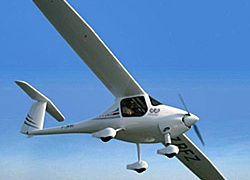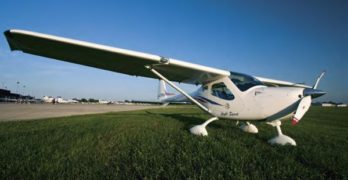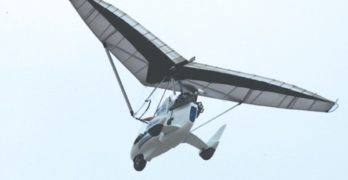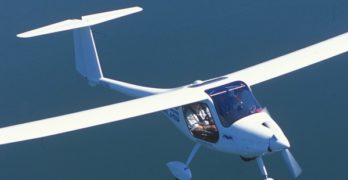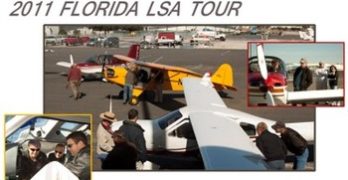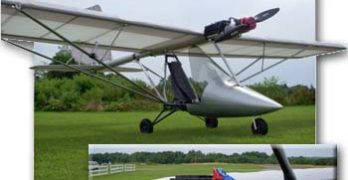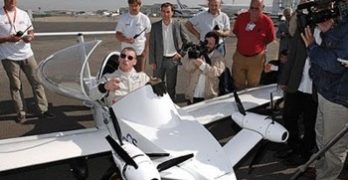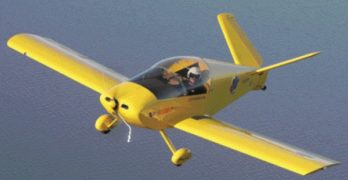After a pause in new SLSA, Pipistrel burst onto the scene with multiple approvals, three at once reports Michael Coates, the importer for Pipistrel USA. We raced to get these placed on the SLSA List because it’s news, but also because FAA uses this list to verify new models before assigning them N-numbers. FAA Registration Branch checks to make sure company names and other info matches incoming applications; we had three calls last week from producers who requested minor changes to our SLSA List after the agency raised questions. *** Now that list swells to 118 models. Pipistrel, which makes long-winged models that soar well, got the Virus approved in both airplane and glider categories, no small achievement. They also gained approval for their Taurus motorglider. The Slovenian company — with production facilities in nearby Italy (partly an effort to adhere to the U.S. government’s bilateral agreement requirement… dull, yes, but important legally) — has been in the news for their electric airplanes and has announced a supersleek four seater, the Panthera.
Search Results for : Rotax electric
Not finding exactly what you expected? Try our advanced search option.
Select a manufacturer to go straight to all our content about that manufacturer.
Select an aircraft model to go straight to all our content about that model.
Up-And-Comer… Remos GX
New Remos GX Rises
An LSA that was 10 years in
the making may aptly be
called a “mature design”
within this nascent sector
of piston aircraft. A few others
share a similarly “ripe, old” heritage,
but most are far newer than the trusty GA
models in which many of us learned the
art of flying.
Designed by engineer Lorenz Kreitmayr,
the first Remos G-3 took to the air
in 1997 (10 years before the upgraded GX
first flew). In 2008, N447RA, the first GX,
arrived in the States for the big summer
flyfest in Oshkosh, and that’s where I had
a chance to update my Remos experience
(previously earned in the G-3). Assisting
and educating me were two Remos reps:
National Technical Service Manager Cris
Ferguson and Managing Director of Sales
and Marketing Michael Meirer.
What’s The Difference?
While G-3 sold more than 250 copies,
performing well for European pilots for
years, the arrival of the U.S.
All-American Revo Sets New Standard
Behold the Revo, a new benchmark in weight-shift trike design.
Look carefully and you’ll see the Revo is not like any weightshift
light-sport aircraft you’ve seen before. The Revo had to
surpass impressive work by larger, more established companies to leap
to the forefront. Any way you look at it, the Revo is simply extraordinary.
I’ve been lucky to fly many trikes over the years. Every few years, one
of the leading producers would make a remarkable step forward in the
design of these flying machines with changes that tended to be evolutionary,
not revolutionary. Among them, I cannot recall a clean sheet of
both carriage and wing debuted as a single aircraft.
Welcome to Revo from Evolution Trikes, an all-new, blazingly fast
American trike like none before it.
The more I examined the Revo and then flew with Larry Mednick of
Evolution (and Tampabay Aerosports), I realized even Air Création’s
beautiful Tanarg trike had been done one better.
Aero and e-Flight Expo… coming soon
Right after Sun ‘n Fun, the e-flight Expo kicks off for the third time at “Aero” in Friedrichshafen, Germany, April 13-April 16. *** Bunches of new aircraft and propulsion technologies along with the awarding of the Lindbergh Electric Aircraft Prize (LEAP) will mark the gathering of 550 exhibitors from 26 countries. *** The e-flight name stands for more than electrical flight innovations: ecological and evolutionary advances in flight regardless of their nature are embraced, although electric is certainly leading the show. *** Erik Lindbergh, grandson of Charles Lindbergh, will present his foundation’s prize for outstanding achievements in the development of electric flight. *** This year should bring several exciting advances in electric flight . I’ll be doing a broad story for Plane & Pilot magazine soon on what’s up and what’s coming. *** Another highlight of the Expo is “History for the Future of Flight”, a tantalizing assemblage of descendants and close relatives of last century’s aviation pioneers: Claude Dornier, Igor Sikorsky, Marcel Dassault and Count Zeppelin.
Flying Cessna’s LSA Skycatcher
Honestly, I never thought I’d see this day arrive. As I started work
on a Cessna aircraft review for the pages of Light Sport and
Ultralight Flying magazine, I thought, We’ve come a long way.
When this publication was started 35 years ago, it was titled Glider Rider
and it featured hang gliders. Coverage then expanded to include powered
ultralights, and now light-sport aircraft (LSA) are included in the mix.
This month I’ve written a pilot report on Cessna Aircraft’s Skycatcher
LSA, the first Cessna in modern memory not built to FAR Part 23 standards,
that is, not type-certified by the U.S. government. Some may say ultralights
“grew up” to become light-sports. But I say that Cessna has moved
(returned?) to very light aircraft designs. I consider their arrival significant.
It isn’t simply that you can buy a brand-new Cessna for $112,500 (more on
the price later). The more important point to Light Sport and Ultralight
Flying readers is that the Skycatcher flies similarly to what light aircraft
enthusiasts fly.
Sleek, Comfortable and Fun; The Sinus Motorglider
Many Americans will agree
the name of this aircraft is odd, and that may be a kind word for the common reaction to “Sinus.” Is the name that important? Sinus (pronounced Seen-us), the aircraft, is a sleek, slender machine capable of impressive performance.
Any soaring-attuned pilot can easily live with the name Sinus for the 49-foot span and, get this, 28-to-1 glide performance! On first glance, except for its elegant, shapely, and thin wings, the Sinus looks like a proper light sport airplane. Pilot Matevz Lenarcic flew one around the world solo, in 80 days, and with zero ground or air support (see “Microlight Motorglider Flies Around the World,” April ’05 UltralightFlying! magazine).
What’s In a Name After All?
Let’s consider that name. U.S. dealer Robert Mudd says Pipistrel – the manufacturer – prefers to pronounce it “seen-us,” not “sighn-us.” They say this refers to a perfect sound wave or sine wave rather than a head cold.
Sebring Wrap Up…and Beyond
I’d call this Day 4 but rush-deadline work for the mag intervened after the last day at Sebring so just getting to it now. *** The Sebring experience gets better every year, I believe precisely because Bob Woods keeps it consistently valuable without tricking it up with a lot of extraneous booths selling things like Miracle Kitchen Knife or iPhone WonderMuffin Pocket Baker and the like: it’s an LSAshow, pure and simple, and a great opportunity for folks to crawl out from wherever winter is tap-dancing on their heads and let them see, compare, fly and even buy aircraft and peripheral stuff.Many airframe makers reported sales at the show, or expected deals to close afterward. Exhibitors hope for sales of course, but realize folks often need to go home, reflect on what they’ve seen, then push the button or think more on it. *** I’d say from everybody I talked to, optimism was rekindled that 2011 will be better than the last — a real toughie.
Part 103 Enthusiasm Continues; Welcome E-Spyder!
Part 103 continues to step from the shadow of Light-Sport Aircraft. We’ve had aviation’s simplest rule (worldwide!) for 27 years and with few exceptions, most of those years saw Part 103 producers laboring in near-obscurity. *** Now, however, a new flurry of activity has developed at the beautiful intersection of genuinely lightweight aircraft with electric power. The very latest to roll into the spotlight is Flightstar‘s E-Spyder, which took its first flight today. E-power from Yuneec in China meets an all-American airframe. The accompanying photos show what a clean matchup these components achieve. *** Flightstar mounted the twin lithium polymer battery packs on either side of the design’s robust main fuselage tube. Electric motors are more user-friendly in nearly every way, but you have some new learning to do. For example, experts advise never allowing lithium polymer batters to drain completely. Fortunately, the Yuneec controlling hardware provides warning systems to help you manage this task.
Envelope Pushers
Two aircraft are getting lots of buzz lately for their advancement of aviation technology. *** First up is the electrified Cri-Cri, which looks like a toy but is in fact an important joint electric R&D project of EADS Innovation, Aero Composites Saintonge and the Green Cri-Cri Association. *** The four-engine Cri-Cri originally debuted as a gas-engine powered, homebuilt acrobatic stunt plane many years ago. EADS modified the Hobbit-sized twin to serve as testbed project for developing electrical propulsion systems on helicopters, drones and other aviation platforms for the future. *** The original stunt plane had two piston mills, maxing out around 30 total horsepower. The all-electric Cri-Cri replaces those with four brushless electric motors. *** The “go-gas” comes from LiPo, or Lithium polymer, batteries, all the rage in RC modeling circles for years for their comparatively high energy density. *** Brushless motors boast 80% or better efficiency, compared to the 20% or less of average internal combustion engines.
Sonex Aircraft’s Y-tailed Waiex
Pedal to the Metal
The Y-Tail Waiex combines unusual style with refreshing speed.
The airlines may be suffering and
Light-Sport Aircraft (LSA) has yet to
coalesce into a coherent industry
segment, but Sonex Ltd. is having a fine run
of business. During my visit on a beautiful
fall day in Oshkosh, Sonex said it was ready
to break ground on a new hangar, the third
building of what has become the Sonex
campus on Wittman Field. At press time, it
was nearly complete.
Sonex is clearly ready for LSA, but
the company has built its enterprise on
delivering kits to the Experimental/ Amateur-
Built community. Steadily selling kits
keeps Sonex in good business shape while
LSA comes into focus. This company is well
positioned for whatever future recreational
flying holds.
$22,260. That calculates to an amazing $148
per mph.
Most of us don’t think in terms of
dollars per mph-and the comparison
with the RV-9 ignores the fact that
the RV is larger, heavier and, as a result,
more cross-country capable-but it
certainly proves that the Monnett machine
won’t take too much of your money for the
speed it can deliver.
- « Previous Page
- 1
- …
- 17
- 18
- 19
- 20
- 21
- …
- 36
- Next Page »


